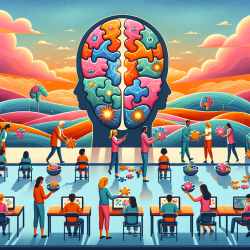Introduction
In the dynamic world of education and therapy, understanding the link between perception and action can transform how practitioners approach their work. The research titled "Persistent neuronal activity in human prefrontal cortex links perception and action" offers profound insights into this connection, emphasizing the role of the prefrontal cortex (PFC) in bridging sensory input with behavioral responses. For educators and therapists, particularly those utilizing online platforms like TinyEYE, integrating these findings can enhance the effectiveness of their interventions.
The Role of the Prefrontal Cortex
The prefrontal cortex is crucial for flexible decision-making and adaptive behavior. This research highlights how persistent neuronal activity in the PFC supports these functions by maintaining a continuous link between stimulus perception and response execution. This understanding is vital for practitioners who aim to foster adaptive learning and behavior in students, especially those with special needs.
Implementing Research Outcomes in Practice
For practitioners, the key takeaway is the importance of creating environments that stimulate the PFC's role in linking perception and action. Here are some practical strategies:
- Task Variation: Incorporate a variety of tasks that require different cognitive demands and response modalities. This can help engage the PFC more effectively, promoting better learning outcomes.
- Self-Paced Learning: Allow students to engage with tasks at their own pace. The research shows that self-paced tasks can help in observing and enhancing persistent neuronal activity, crucial for learning.
- Stimulus-Response Activities: Design activities that require students to process sensory information and make decisions, thereby strengthening the perception-action link.
Encouraging Further Research
While this study provides a foundational understanding, it also opens doors for further exploration. Practitioners are encouraged to engage with ongoing research to refine their approaches continually. By staying informed, educators and therapists can adapt their methods to incorporate the latest scientific insights, ensuring they provide the most effective support to their students.
Conclusion
Understanding the intricate relationship between perception and action through the lens of the prefrontal cortex can significantly enhance the practice of educators and therapists. By implementing strategies that leverage this knowledge, practitioners can foster environments that promote adaptive learning and behavior. To delve deeper into this fascinating research, you can read the original paper by following this link: Persistent neuronal activity in human prefrontal cortex links perception and action.










